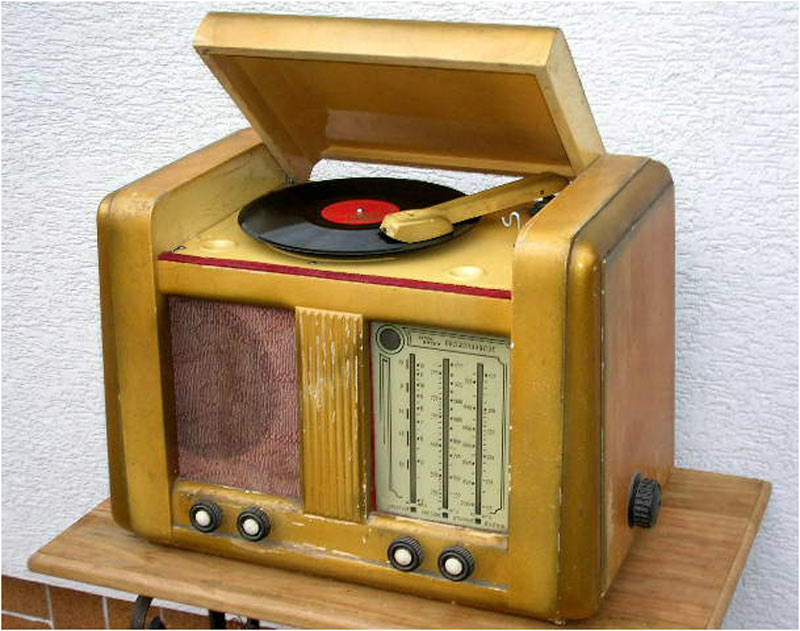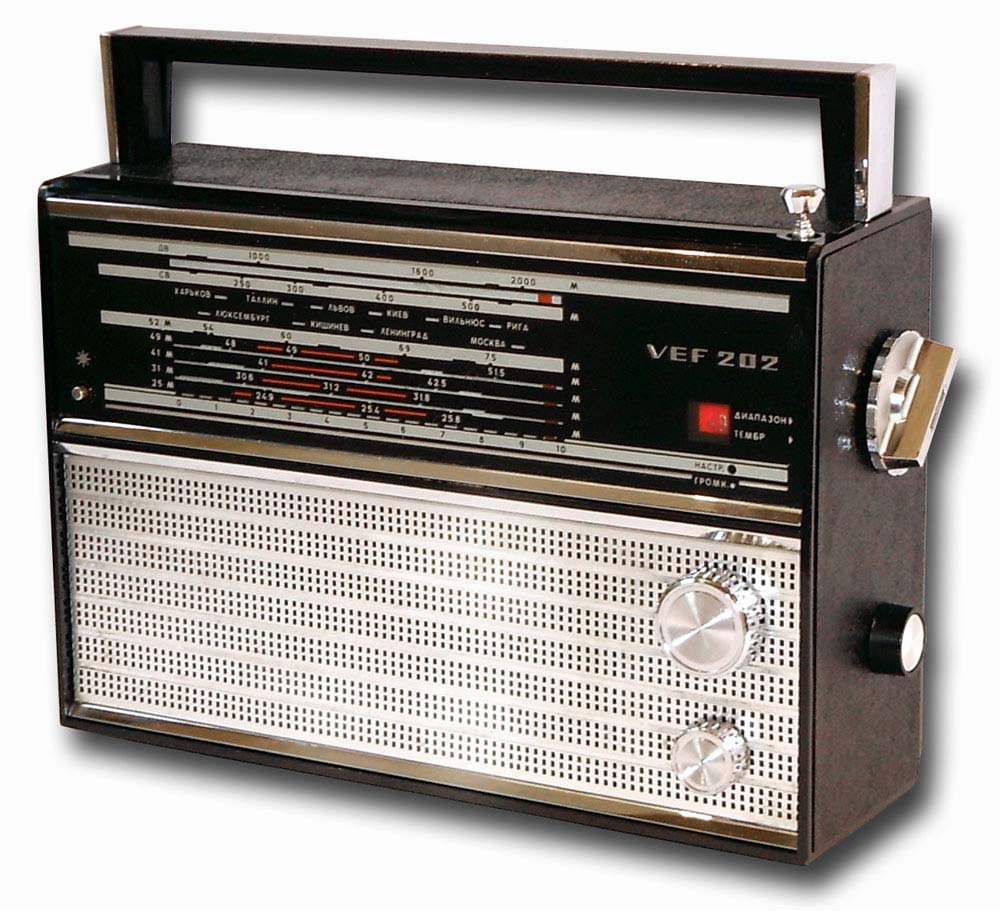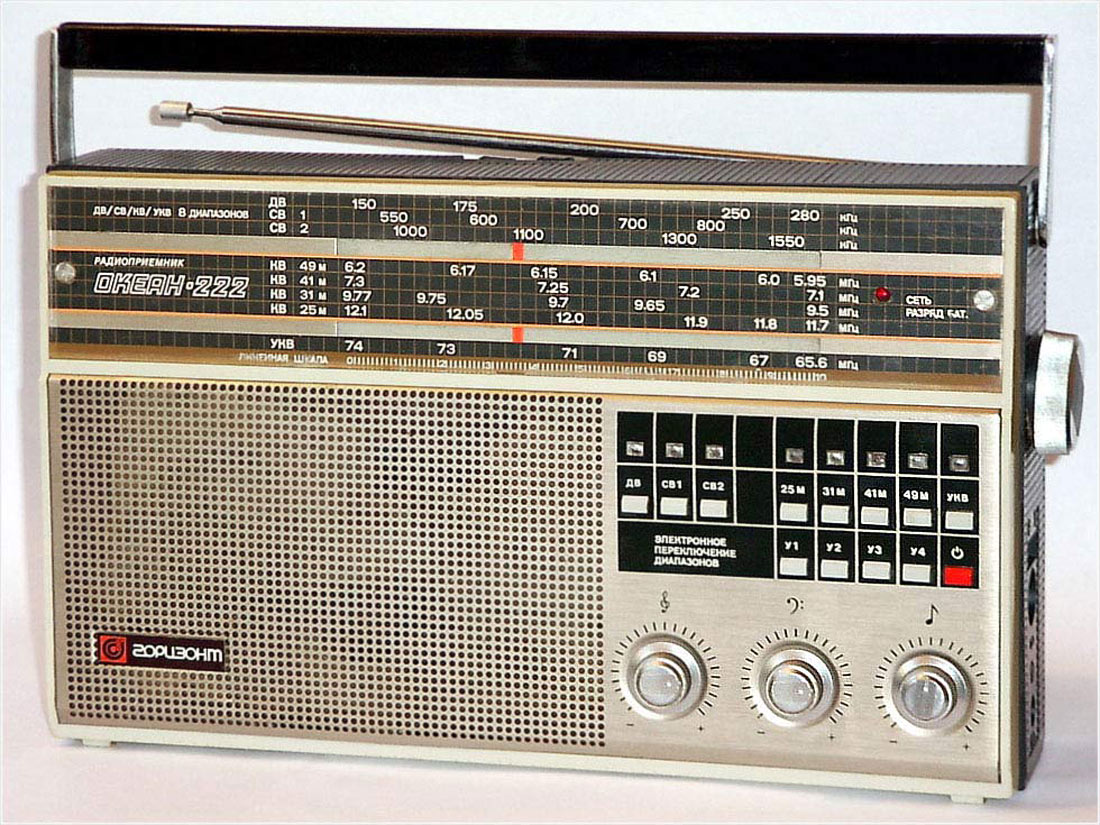Dilettantism , or dilettantism (from Italian dilettante ← lat. Delectatio "amusement, fun") - engaging in any activity (for example, science, art, craft) without proper knowledge and professional training.
This quote from Wikipedia accurately describes my relationship to radio engineering. I am not a radio amateur or radio professional, I have never even assembled my own detector receiver. I am a radio user who has been using this technology all my life "without proper knowledge and training." If you do not get distracted by wireless data networks (which in a sense are also radio ), radio reception ala naturel, the main source of information for my great-grandfathers and great-grandmothers, is now used less and less. The last outpost of this activity, listening to radio stations in the car on the way to work, was destroyed last year by self-isolation. This article is an unscientific collection of radio-related aesthetic experiences. Plus some photos of radios.

I'll start with the most important thing: broadcasting is the longest-lived high-tech legacy I can imagine. Yes, there is telephony, but over the past 20-30 years it has changed beyond recognition. Personal computers are only half a century old, not enough. Records are alive and well, and this is really an ancient technology, but not so much: the gramophone records of the beginning of the last century have many differences from modern ones. But with radio reception - maximum stability. So much so that I can turn on the receiver in my 2016 car and receive a radio signal sent by a transmitter from a century ago.
I keep a diary of a collector of old pieces of iron in Telegram .
Compatibility
My area of retro interest is computers and home electronics, and I'm used to dealing with outdated technology that seems to have been relevant only recently. With 15-year-old laptops that can't really go online. With 10-year-old smartphones that have almost lost touch with the infrastructure of the manufacturing company. I somehow complained about such unplanned (I am sure there is no and there was no malicious intent) obsolescence in this article . Then I thought: are there any technologies that have not changed over the years and still work? More or less complex is desirable, otherwise it can be agreed that the most stable achievement of mankind is the wheel (still round!). Or a hammer.
And now there are very few of these complex technologies without radical changes. Photography is now digital, for fifteen years now I have not been able to develop film in the "old way" at every corner, and this film is significantly different from the early technologies of the nineteenth century. Telephony no longer connects two subscribers with a long copper wire, instead of it there is also a digit, and you can only emulate an analog phone (or an ancient modem) using adapters. Any physical medium has become almost irrelevant, although the CD is still holding, but one cannot say that "this CD was listened to by my great-grandfather." Of course, here I deliberately limit myself to consumer stuff, but, forgive me, with all my desire, I cannot collect, for example, steam locomotives. So, I have no other examples of almost complete compatibility of standards, receivers, transmitters,throughout history, from invention to modern times, apart from radio communications. If you want to argue, welcome to the comments.
The video above is from Mr. Carlson's Lab. It is not entirely entertaining, the author of the video consistently and in detail describes the repair process for most of the very old devices. And every time he finishes repairing an 80-year-old radio receiver, he turns it on - and receives modern radio broadcasting on medium waves, without any problems. The example with my car at the beginning of the article is a bit stretched. If I screw a streaming drive onto it , accelerate to 88 mph, and move to 1916, then at best I can receive experimental broadcasting, or Morse code in any quantity. But then there was very little time left before regular broadcasting. Examples: Netherlands in 1919, USAin 1920, from the Shukhov radio tower in Moscow - in 1922. Frequencies - 3000 meters (~ 100 kilohertz, long waves) in Moscow, 1020 kilohertz (medium waves) in Pittsburgh, 300-375 kilohertz in The Hague. One hundred years of compatibility, no computer technology has dreamed of this.
Collecting
Before the massive spread of television, radio broadcasting was the only way to receive information in real time, a substitute for the Internet for our ancestors. Radios have represented the pinnacle of consumer technology for decades. In the mid-fifties, the first transistor receivers appear, the radio becomes portable. Before that, a radio was usually understood as a large tube chest exclusively for home use. The first such device in our family that has survived to this day is the Ural-49 radio , released in 1949 (hereinafter, photographs are taken from the site rw6ase.narod.ru ).

Further in the history of family gadgets, the failure to the seventies, to the portable radio VEF-202 :

Professional radio receiver of my childhood - ISHIM-003 :

The subject of my envy: the Ocean-222 radio receiver with electronic band switching and VHF support:

Radios hold great historical value, both in terms of technology and design. I haven’t started collecting this category of retro devices yet, and it’s not a fact that I’ll gather: there is little practical use for them, but they take up a lot of space. And if I suddenly buy a receiver for the interior, I will be looking for something with support for the modern FM range of 88-108 MHz.
Personal history
Due to my age, it was FM radio that played an important role in my life. With the standardization of broadcasting in the VHF range, everything was somewhat more complicated than in medium waves. The first radio stations of this format appeared in the United States back in the forties of the last century, and used the 42-50 MHz range. In 1945, the local regulator moved broadcasting to the usual range, then still limited to frequencies of 88-106 megahertz. In 1949, broadcasting on the old frequencies was discontinued, tens of thousands of expensive radios became useless overnight. Something similar happened on the territory of the former USSR in the early nineties. Imported equipment supported the "western" frequency range of 88-108 MHz, the Soviet one - the local 65.9-74 MHz. In Japan, the range of 76-95 MHz is used, which causes problems for buyers of used right-hand drive foreign cars.
Frequency modulation broadcasting is the first implementation of what is now commonly referred to as Hi-Fi. Wide bandwidth stereo sound (30 Hz - 15 kHz), low noise. With a very limited range of cassette and vinyl music, music radio is a window into the world. The advantages of FM over AM broadcasting are steeper than the transition from DVD to HD Video in the early 21st century.

In the early nineties, I got my first personal audio player with a built-in radio receiver. How many cassettes can you take with you in your pockets? I got 5-6 pieces. The radio gave an endless (or so it seemed) range of music, extended the life of half-dead batteries, and at the same time (due to the discrepancy between the Soviet and Western bands) allowed listening to the sound from the third television program.
In my collection there are a couple of boxes of cassettes: someone all his life, in the seventies and eighties, consistently recorded jazz programs from the radio. Yes, the quality in the end is a little worse than if you rewrite from vinyl. But the radio broadcasts live performances, which may have survived only in my closet, and no one else. Now I would give a lot to listen to radio stations from the nineties, remember the repertoire, and jingles, and advertising. The last radio phenomenon in my history was the Moscow station 106.8 FM , broadcasting electronic music that I could not hear anywhere else.
The most pleasant childhood memories I have, however, are associated with radio reception at medium wavelengths. VHF (or FM) was then available in major cities. Drive about 50 kilometers from the regional center and switch to NE. I remember very well my grandfather's portable radio, which he took with him on fishing trips and to the dacha. And how an unexpectedly flying thundercloud unexpectedly improved reception from two to two dozen stations.
Strange noises
Everyone knows how FM radio sounds. It is on medium and short waves that a unique experience of listening to radio stations arises. If you turn on the radio at these frequencies in an ordinary city apartment, most likely it will be possible to catch only interference from your (and neighboring) switching power supplies, it is better to get out of town. And there "SV" and "KV" sounds the same as 30, 50 and 70 years ago. It’s not the content that is important to me, but the atmosphere of this low-quality radio reception.
Clicks from lightning from a thundercloud a dozen kilometers away from you. The howl of high-voltage wires, clogging up the radio wave when you pass under the power line. Interference from a station on an adjacent frequency, sounds of radio beacons. And, of course, otherworldly noises, the nature of which you can sometimes explain, and sometimes you do not have enough knowledge. Numberedradio stations broadcasting a sequence of letters in a wooden voice, roaring digital radio broadcasts. Distorted voices of radio amateurs broadcasting in SSB mode . This noise forms the basis of musical compositions, and for many people a little older than me, it created a unique soundtrack of their youth. Here are two examples. A cryptic message from a "secret" radio station known as The Swedish Rhapsody :
And the archive of recordings of the Rock-Posevy radio broadcast by Seva Novgorodtsev. The transmission, attributed to the "enemy voices" on the territory of the USSR, was systematically jammed - powerful transmitters were working on the frequencies of the BBC radio station, jamming the signal. Part of the archive is the late broadcasts of the recordings on FM radio. But many of the programs are the same ones recorded by radio amateurs around midnight from a shortwave radio with "as lucky" quality. Here's an example of a good recording from 1984. But the record is worse... The history of radio is also the history of a technology capable of spreading information practically all over the world, over hundreds and thousands of kilometers. And a history of trying to limit the spread of what is considered harmful. This is now being repeated with a different set of technologies. Reception at medium waves, with all the interference and distortion, the cut-off frequency band, gives an incredible sense of connection between different eras, between living people now and the long-gone ancestors who invented this radio, made their way through atmospheric noise and brought words and music to us, in anywhere on earth. Almost as much later the Internet could do it, but… more sincere or something.
Modernity
Each of us has a radio receiver somewhere, but more often it is built into other devices. Into a cassette player, stereo or home theater receiver. In a mobile phone - I have quite a few of them, and some (Nokia N900 , for example) can not only receive FM radio, but also broadcast a signal for a couple of meters. I have only one clean radio receiver - a relatively modern Tecsun PL600:

Consumer radio is not what it used to be. FM stations have been commercialized and no longer give me the opportunity to hear new music. More precisely, they provide, but do not match my tastes - it is easier to find it on the Internet. Modern radio substitute - music streaming without DJs and ads, with automatic playlists based on your preferences. It works surprisingly well. And if you want to listen to a live person, there are podcasts and traditional Internet radio stations from all over the world. It is no longer necessary to turn on the radio at night, trying to catch the very same wave. You can listen to it on the Internet - for example, the avant-garde radio KEXP from the USA or the provincial Radio Day , which was firmly stuck in the nineties.
Radio on medium waves still exists, although in the Moscow region it is better to wait until the sun sets, the range will be much larger. I regularly take the radio on trips: I go out into the street in the evening, listen to Radio Cuba while in Boston, or Bibisi from the island of Tenerife. All over the world, you can catch Chinese radio broadcasts in all languages of the world. In the suburbs, I enjoyed listening to the radio broadcast of North Korea, which seems to be broadcasting directly from 1950.

I want to end this emotional and inconsistent opus with one more photograph of a radio set, imported for a change. As a child, I was very attracted to similar names of cities on the scale of the radio "Belarus". We can say that this was an attempt to simplify the user interface - not write soulless frequencies, but the names of cities and individual radio stations that you can connect to right now. Now the optimism of those who drew these scales is surprising. Did they really think that these correspondences "city - broadcasting frequency" - for centuries? In today's world of accelerated progress, annual updates of gadgets, this consistency is a little lacking.
How I miss the pleasant atmosphere of my grandmother's kitchen, on which all my childhood hung a three-program radio and never turned off. There I ate the food of the gods, scrambled eggs according to a special recipe "as I like", to concerts of classical music, to theatrical performances, "latest news" about the state of the sowing campaign, children's fairy tales. That is why, although I never became a radio professional (I didn't even try), classical, traditional radio for me is an important sign of the passing era.